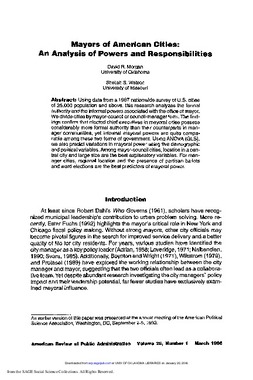| dc.contributor.author | David R. Morgan | |
| dc.contributor.author | Sheilah S. Watson | |
| dc.date.accessioned | 2016-01-14T19:53:08Z | |
| dc.date.accessioned | 2016-03-30T15:36:59Z | |
| dc.date.available | 2016-01-14T19:53:08Z | |
| dc.date.available | 2016-03-30T15:36:59Z | |
| dc.date.issued | 1996-03-01 | |
| dc.identifier.citation | Morgan, D. R., & Watson, S. S. (1996). Mayors of American Cities: An Analysis of Powers and Responsibilities. The American Review of Public Administration, 26(1), 113-125. doi: 10.1177/027507409602600106 | en_US |
| dc.identifier.uri | https://hdl.handle.net/11244/25085 | |
| dc.description.abstract | Using data from a 1987 nationwide survey of U.S. cities of 25,000 population and above, this research analyzes the formal authority and the informal powers associated with the office of mayor. We divide cities by mayor-council or council-manager form. The findings confirm that elected chief executives in mayoral cities possess considerably more formal authority than their counterparts in manager communities, yet informal mayoral powers are quite comparable among these two forms of government. Using ANOVA (GLS), we also predict variations in mayoral power using five demographic and political variables. Among mayor-council cities, location in a central city and large size are the best explanatory variables. For manager cities, regional location and the presence of partisan ballots and ward elections are the best predictors of mayoral power. | en_US |
| dc.language.iso | en_US | en_US |
| dc.publisher | The American Review of Public Administration | |
| dc.title | Mayors of American Cities: An Analysis of Powers and Responsibilities | en_US |
| dc.type | Research Article | en_US |
| dc.description.peerreview | Yes | en_US |
| dc.description.peerreviewnotes | https://us.sagepub.com/en-us/nam/manuscript-submission-guidelines | en_US |
| dc.identifier.doi | 10.1177/027507409602600106 | en_US |
| dc.rights.requestable | false | en_US |
